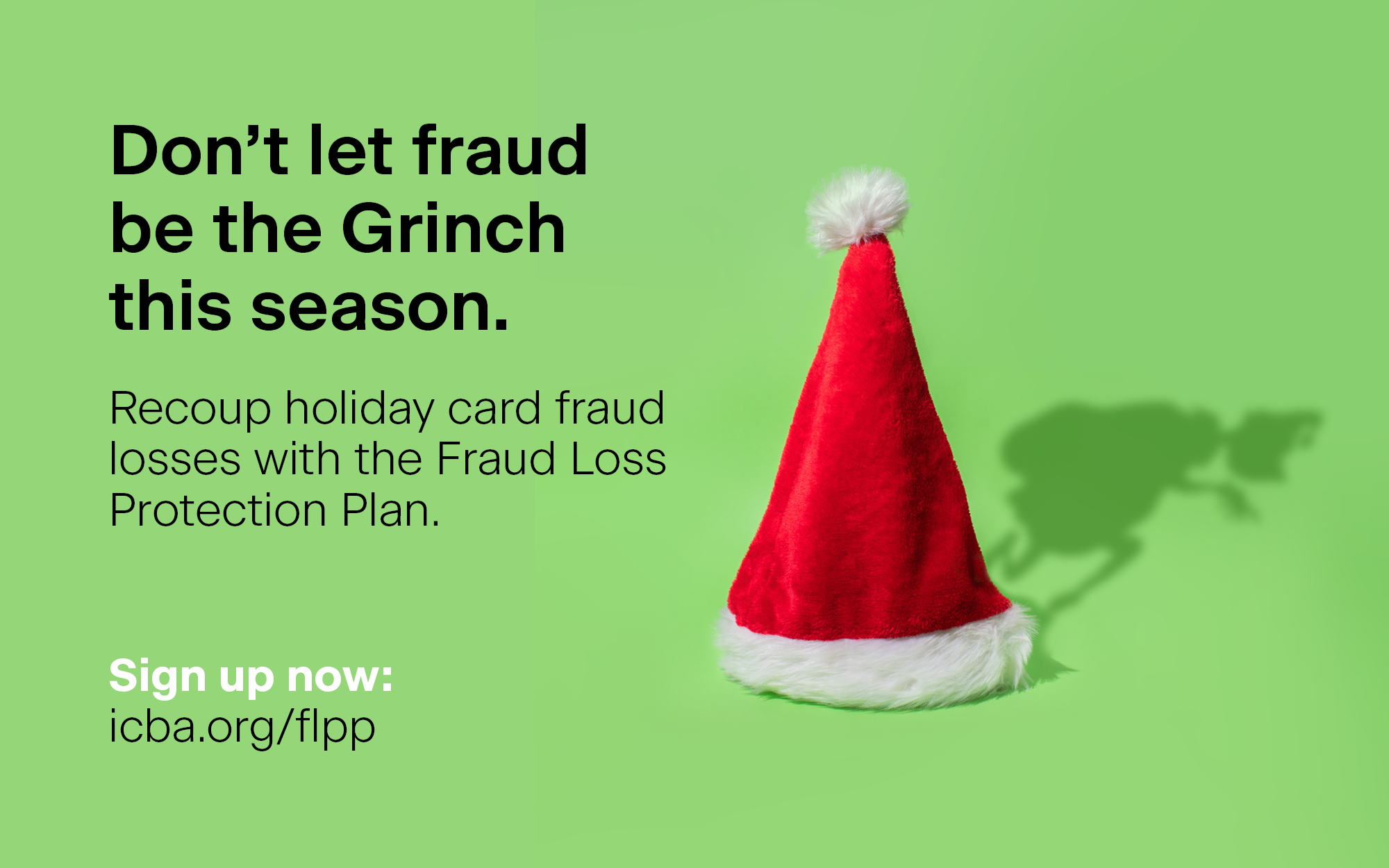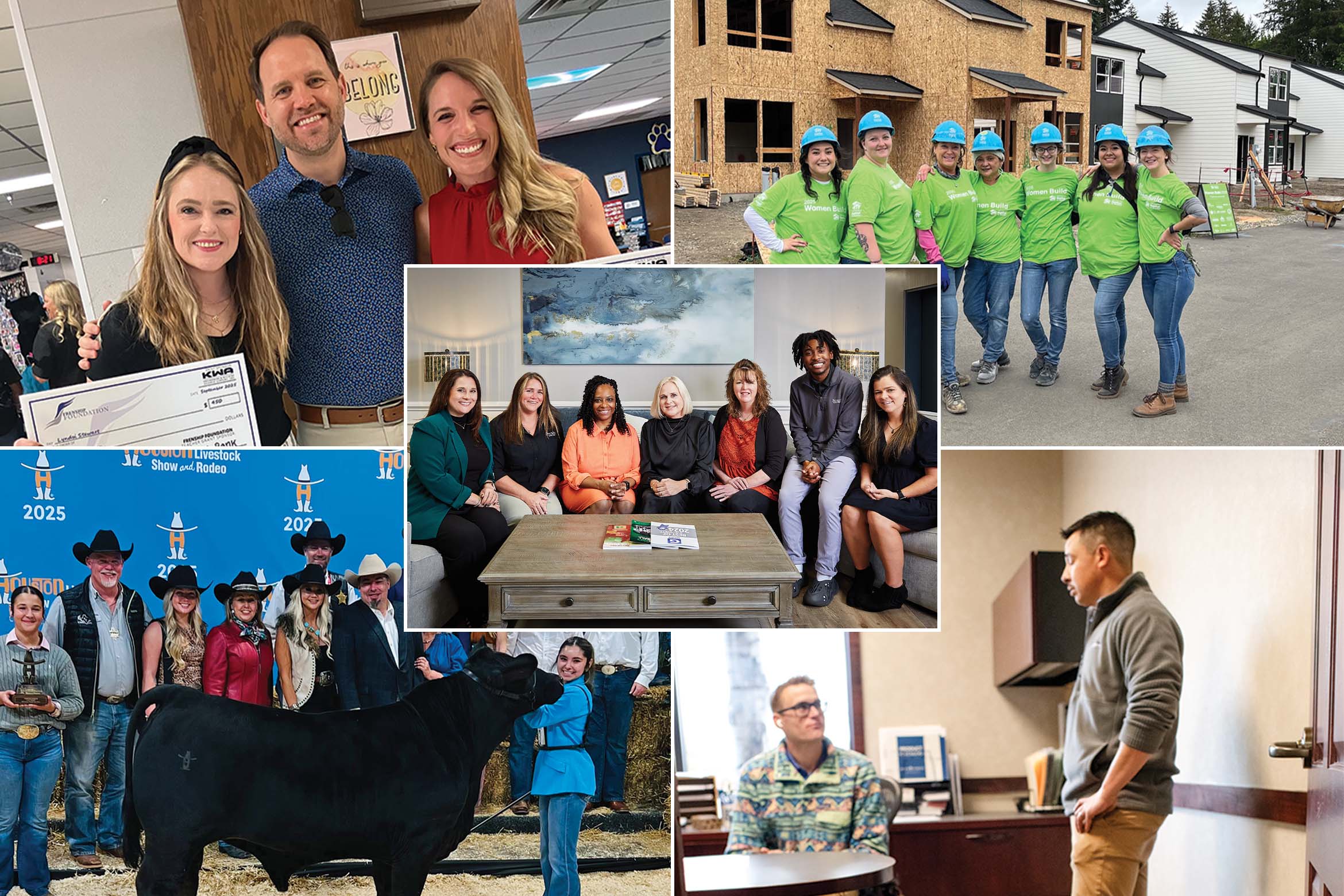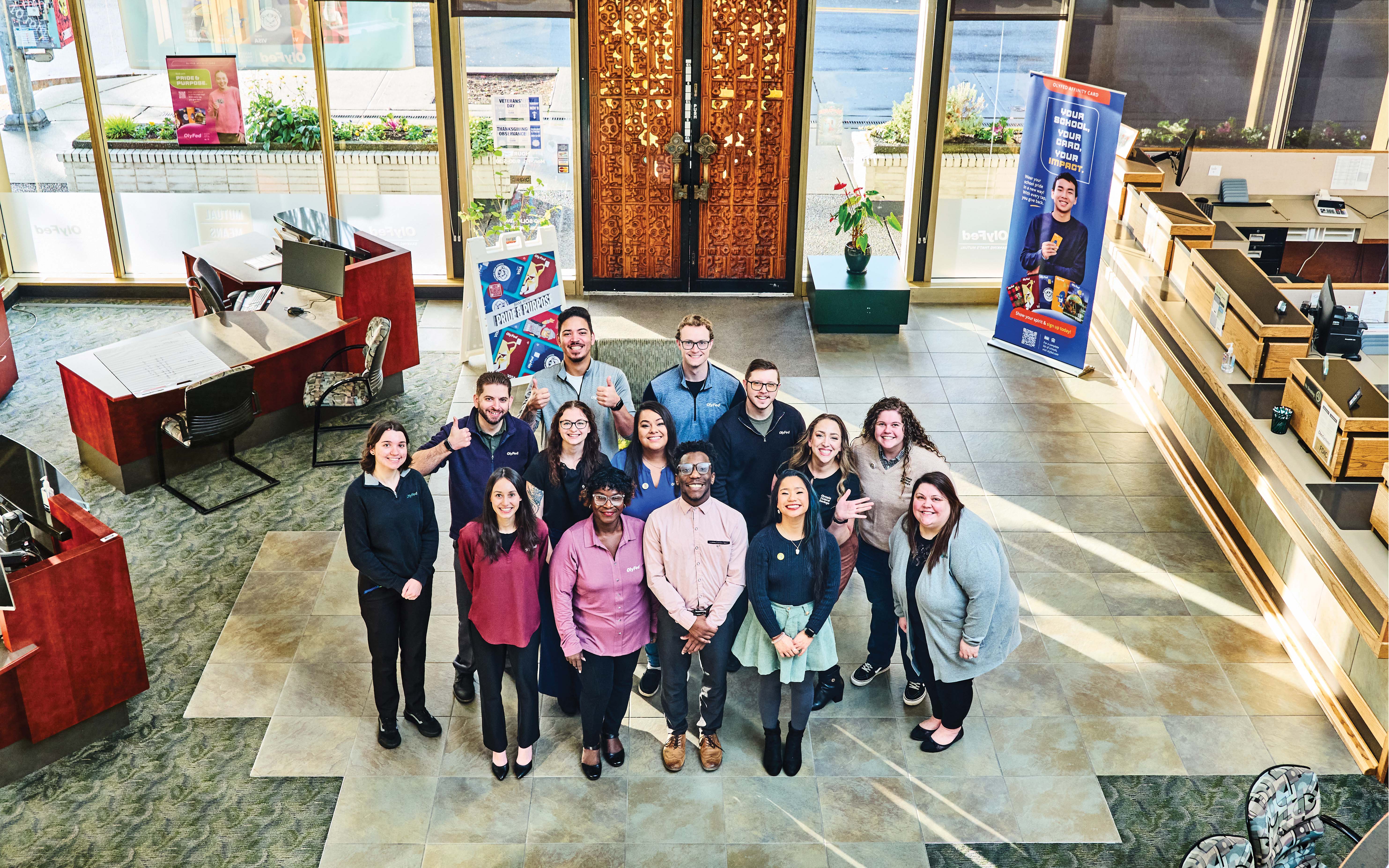Phelps County Bank in Rolla, Mo., and Woodsboro Bank in Woodsboro, Md., know their deep community roots require continual tending. That’s why their outstanding charitable work has earned them recognition as ICBA’s 2024 National Community Bank Service Award winners.
2024 National Community Bank Service Awards
September 03, 2024 / By Tarra Willox
Phelps County Bank in Rolla, Mo., and Woodsboro Bank in Woodsboro, Md., know their deep community roots require continual tending. That’s why their outstanding charitable work has earned them recognition as ICBA’s 2024 National Community Bank Service Award winners.
National Community Bank Service Awards: Exceptional Community Bank Service Award
Awarded to a bank that developed its service program three or more years ago
Better futures for kids, one lemonade stand at a time
By Rachel Hatcher
Back in 1996, communities in Phelps County, Mo., made a startling discovery. Out of the 46 judicial circuits in Missouri, Phelps County and the 25th judicial circuit had the third highest child abuse rate in the state. A group of volunteers, concerned citizens and local organization leaders—among them Emma Lou Brent, then CEO of $484 million-asset Phelps County Bank (PCB)—came up with an action plan that would address the issue.
Brent went back to her community bank in Rolla, Mo., inspired to act. She proposed that PCB “encourage kids to help kids” by putting on an event where children could sell lemonade in their communities, with the proceeds going to nonprofits that aim to reduce child abuse.
Since then, PCB has set aside a weekend each July to collaborate with the Phelps County Child Advocacy Network (PCCAN), an organization founded in 1993 to assist in the county’s child abuse awareness, prevention and reduction efforts. The two organizations dubbed this event “Take-a-Stand Against Child Abuse.”
It all starts with art
Since it was founded, PCB’s Take-a-Stand Against Child Abuse program has grown in both number of lemonade stands and in terms of how they get people involved. The event takes extensive preparation, beginning in January of each year.
It all starts with some good, healthy competition for local first to fourth graders. PCB calls on students to create the event’s signature T-shirt design, based on the community bank’s pre-established theme. This year’s event had a carnival theme with the tagline, “Step Right Up for Kids.”
“We partner with the Phelps County Elementary Schools, private schools and homeschool parents, and run our Take-a-Stand poster contest,” says Linda Goff, vice president of marketing at PCB. “And it is thousands of posters. The art teachers [at each school] choose their favorites, and then those come to the bank.”
PCB brings in the finalists for a ceremony in its lobby, during which children receive prizes and ribbons for their achievements. One child’s design is chosen to be on the front of every Take-a-Stand T-shirt, and the art teacher who chose it as their favorite receives a $500 art supplies scholarship, courtesy of PCB.
Local organizations can also host a lemonade stand, advertise on the T-shirts and sponsor the event. “Our sponsors on the back of the shirts account for the largest bulk of what we are bringing in,” says Dominic DeLuca, PCB’s CEO. “We’ve gotten some great community partners that are committing to participating each and every year.”
DeLuca notes that sponsoring businesses often buy shirts for their entire staffs. “If you walk into a lot of businesses in the area during [the event weekend], they’ll all be wearing our Take-a-Stand shirt, which again just increases the awareness,” he says.
For the July event, Phelps County Bank gathers organizations, individuals, families and children to host lemonade stands within the county towns. In June and July, people can start signing up to run a lemonade stand and buy the official event T-shirts. On average, the event places about 50 lemonade stands across Phelps County, but this year, PCB had a record-breaking 73 stands. Most of these lemonade stands are located in Rolla and Saint James, two of the county’s larger towns, but even out-of-towners will occasionally step up to support the cause. For many families, it has become a tradition; children who participated during the event’s inception are now parents themselves.
Employee-driven action
Much of the community’s awareness and involvement can be attributed to the work of PCB’s staff. Goff says that PCB, being 100% employee-owned, has built a culture where employees have agency, investment and pride in the bank’s community involvement, including through Take-a-Stand Against Child Abuse. The community bank’s employee-owners work to ensure everything runs smoothly.
“It’s a huge investment, but because we are employee-owned, that makes us more generous,” says Goff. “Everyone who works here feels that ownership and wants to give back to the community, and it’s sort of the engine that powers Take-a-Stand.”
PCB’s employee-owners start conversations about the event, whether that’s when selling T-shirts, wearing the T-shirt to work or the store, posting on social media or asking local organizations if they’d like to sponsor the event (among other efforts). They’re also the ones who assist during the event, refilling supplies, collecting funds and depositing those funds at the bank to keep track of the running total—plus so much more.
According to DeLuca, PCB has an incentive that boosts employee-owner participation even further. “We have a volunteer rewards program throughout the year, and for every hour that you volunteer outside of business hours, you can earn $10 in cash,” he explains. “Or you accumulate that benefit and can choose to donate it to Take-a-Stand or really any other nonprofit, if you feel strongly about that.”
Support beyond the bank
The money raised by PCB’s Take-a-Stand Against Child Abuse event—both from the event-related sales and any donations provided separately—goes to Phelps County Child Advocacy Network, and PCB and PCCAN meet every year to discuss which nonprofits will receive the funding.
Such organizations, including Court Appointed Special Advocates, help children in myriad ways, including mitigating drug abuse that often leads to child abuse, supporting children in foster care or precarious housing situations, and making one-time payments for emergency expenses such as heating bills to ensure families’ well-being.
Three or four weeks after Take-a-Stand, PCB invites all lemonade stand hosts to the bank for a party, where they give away prizes and announce the grand total raised for its targeted organizations. After 29 years running this event, PCB has raised about $925,000, with a $1 million goal by the event’s 30-year anniversary in 2025.
Goff says PCB is grateful that the community comes together year after year to support such an important cause. Speaking to bank and program patrons, she says, “You do business with us, and because you do business with us, you are making our generosity possible. That’s really what it comes down to: We’re able to do this because of the community.”
National Community Bank Service Awards: Emerging Community Bank Service Award
Awarded to a bank that developed its service program less than three years ago
Planting trees for the good of Chesapeake Bay
By Tarra Willox
The forests and trees around Chesapeake Bay, which runs for about 200 miles across six states and the District of Columbia, play a vital role in filtering drinking water and reducing flooding for residents along the watershed. Along this stretch resides $425 million-asset Woodsboro Bank, which has joined the effort to improve the bay’s water quality.
About a year ago, Doug Murphy, SVP and commercial credit manager at the Woodsboro, Md., community bank, came across an article in a local newspaper about Maryland’s Five Million Trees Initiative, a plan to plant five million native trees in the state of Maryland by 2031. This supports an initiative led by global organization Plant-for-the-Planet to plant one trillion trees worldwide.
Murphy attended a presentation with the Maryland Department of Natural Resources (DNR) and participated in a tree planting event with one other Woodsboro Bank associate. After learning more about participating in the tree planting events, Murphy decided to get the whole bank involved.
This past April—the month in which both Earth Day and Arbor Day are celebrated—employees of Woodsboro Bank gathered for their first tree planting event in support of the Monocacy River Farm Stewardship Program. The program brings together different partners in the community to execute large-scale tree planting events on participating farms, aiming to reduce flooding, improve water quality and help maintain the wildlife habitat.
Joining Woodsboro Bank employees at April’s event were associates from the Maryland DNR and the Chesapeake Bay Foundation (CBF), an independent conservation organization dedicated to restoring the bay.
Rob Schnabel, Maryland restoration scientist for CBF, says, “What happens on the land has a humongous impact on the Chesapeake Bay and the rivers and streams. So, one of the most cost-effective practices for filtering and cleaning water is planting these streamside forest buffers. They filter any pollution running off the land. They also help recharge streams by basically restoring the sponge along streams.”
A huge need for forests
Maryland is composed of 23 counties, and each one has established a goal for how many acres of forest buffer it plans to establish by 2025. Frederick County, where Woodsboro Bank is located, makes up one third of the statewide goal. According to Schnabel, there is a huge need for forests along the streams in Frederick County.
Before setting out to work at April’s event, Woodsboro Bank staffers were briefed on the process of planting riparian buffers, or streamside forests, and Schnabel discussed the unique characteristics of the watershed where they would be planting.
“[Schnabel] was educating everybody about the process of what we were doing to plant trees to make sure runoff doesn’t go into the creek, which was literally 100 yards or less from where we were, and how they rotate cows and livestock on the pastures there,” says Murphy. “He let us know what we were doing—not just planting trees, but the impact that it has going forward.”
Aiming for 100% participation
April’s tree planting event was Woodsboro Bank’s first all-colleague service activity, and the team wanted to ensure everyone played a role. Instead of closing all the bank’s branches, the team decided to keep two branches open for people who couldn’t attend due to scheduling or other health-related issues.
“We really had 100% participation,” explains Murphy. “The people who didn’t physically go plant trees were [at the branches] to keep the bank open to the public so that all the other people could physically participate.”
A few Woodsboro Bank colleagues brought their children along to help at the event. “It’s definitely something that we would love to have colleagues bring their kids, bring friends and family,” says Murphy.
Samantha Cutrona, marketing director at Woodsboro Bank, says the group was briefed on questions like “Why do you loosen the roots?” and “Why do you do certain things to help the trees grow?” The community bankers learned how tree roots help hold stream banks together, and that, since the team was planting on an agriculture watershed, the roots also work to filter out farm fertilizer or other pollutants before they enter the stream system.
Woodsboro members also learned how streamside forest buffers play a vital role in providing and maintaining a healthy wildlife habitat in the area. For example, an optimal trout habitat requires cold, clean and highly oxygenated water. The tree buffers work to clean the water and provide shade cover for the stream systems, keeping it cooler and more oxygenated.
After planting for about three hours, the team had a small reception to debrief and provide more information for Woodsboro Bank colleagues about working further with the Monocacy Farm Stewardship Program through smaller-scale events to keep up momentum and expand awareness of the cause.
Connecting the community
Woodsboro Bank’s focus on tree planting didn’t stop with April’s event. In collaboration with Tree-Mendous Maryland, a Maryland Forest Service program aimed at restoring tree cover in the state, Woodsboro Bank is planning to participate in a donation program called Gift of Trees. Through this program, the community bank plans to donate native trees on behalf of new mortgage clients. Tree‑Mendous Maryland will arrange for the trees to be planted in the Maryland county in which the recipient of the certificate resides.
“The plan is, for new mortgage clients, that we donate to the state program, and they plant a tree in that person’s name, and then we give them some acknowledgment to our client,” says Murphy.
Cutrona also highlighted the interconnected nature of the Monocacy River Farm Stewardship Program. The farm on which the Woodsboro bankers were volunteering is connected to the farm down the road, because it holds livestock, and the farm across the street produces the grain that feeds those animals.
Woodsboro Bank plans to continue its efforts, in order to keep those connections and maintain water quality in the region.
“We would definitely do this again, just make it bigger,” says Cutrona, “and allow families and friends to be part of our team doing it. So, just expanding our outreach and expanding the awareness of the program not only to our colleagues, but to our community as well.”
National Community Bank Service Awards: Honorable Mentions
Exceptional Honorable Mention
Opening up funding to local nonprofits
Ulster Savings Bank in Kingston, N.Y., has made a point to support nonprofit organizations and connect them with grants. Ulster Savings’ vice president of marketing Connie Harkin and chief operating officer John Finch discuss the community bank’s efforts.
Q: Why is Ulster Savings Bank so dedicated to charitable giving?
John Finch: About 25 years ago, the board of trustees decided that in addition to the regular giving they do throughout the year, they wanted to create a foundation that would be funded solely by the bank. It would be for the sole purpose of doing things for nonprofits in the community and helping where they see the biggest need.
Connie Harkin: Unlike [some] banks [and credit unions], we have two ways of giving. We have the [Ulster Savings Charitable] Foundation and then our donation program. Not a lot of banks have two separate programs to give back to the community from a monetary standpoint.
Q: What community issues do you focus on?
Finch: A lot of it is around housing, [health and human services and education]. When COVID happened, one of the things we did proactively was we went out to the organizations that we felt were going to be impacted the most … There’s only so much money and there’s so much need, and the challenge is [determining] how to prioritize some of that.
Q: How do you choose which organizations you connect with grant money?
Finch: There are two ways. One is that people apply to the foundation, and we have a group that reviews the applications. We’ve tried to streamline the applications so that we’re not making organizations spend days and weeks filling them out. We try to make it pretty basic, and then if we have other questions, we’ll go back to them and ask them. On the proactive side, it’s really our board members who are seeing and hearing things happening in their communities … They may hear that a [program] is short of its goal to do something, and that’s where the group will discuss and make a decision on things that we want to do proactively.
Q: What’s one of your program’s success stories?
Harkin: The founder of the MyKingstonKids nonprofit came from New York City and established some programs for children here in our area … [Many] big banks turned him away, so he came to Ulster Savings Bank [for funding] because of word of mouth of what we do in the community. And we’ve been supporting his organization for [about] eight years now.
Q: How do Ulster Savings Bank employees feel about its initiatives?
Harkin: [The initiatives are] the reason why a lot of us are here. I’ve been with the bank for 30 years, and it’s amazing the doors that open being an employee because you become active in the community. … We’re involved with events, and you get to meet people and understand stories that you never would have been exposed to had you not worked here. And I have to tell you, Ulster Savings Bank is so supportive in that they give employees the resources to volunteer.
—Oludare Obadiya
Emerging Honorable Mention
Beyond apples: Getting teachers what they need
In 2023, FreedomBank in Elkader, Iowa, ran a supply drive for local teachers, who often have to pay for classroom supplies out of their own pockets. President and CEO Kathy Mueller and marketing officer Sara Hertrampf discuss the results and what’s next for the community bank.
Q: Why did FreedomBank create the Supplies for Success drive?
Sara Hertrampf: We wanted to reach out to the teachers and see what they specifically needed for their classrooms. It started more as a wish tree or giving tree idea, but instead of doing it at Christmas, we would do it at back-to-school time to be able to let teachers come in, fill out what they need specifically for their classrooms and then people would donate. … Part of the impetus behind it was that we could do something that would help the teacher specifically and empower them to find things that they need in their classroom.
Q: What was the outcome of Supplies for Success?
Hertrampf: We had a range of [requested] items, such as special books, headphones, rugs for their classroom and special storage stuff, [plus] things for kids, like fidget things at their desk. Some [teachers] had very general needs, like Kleenex and Clorox wipes … They spend a lot of their own money supplying their classrooms and buying things that students need—everyday things like socks and feminine hygiene products, snacks, [etc.]. So, we wanted to help reduce some of that burden that falls on teachers by seeing if we could act as a conduit to get the community and our team to donate.
Q: How does FreedomBank decide where help is most needed within the community?
Kathy Mueller: As a staff, we have people involved in a lot of community organizations—whether it’s economic development, relationships with the schools, the scholarship programs or [the nonprofit] Junior Achievement. We have people who are 4-H leaders ... I think just by being in the community and visible and having ears to the ground—[knowing] what kind of things are happening, what opportunities, what maybe less-than-positive things we might see on the horizon—gives us an opportunity to act appropriately.
Q: Why is community work so important to FreedomBank?
Mueller: I’ll say that it supports our tagline: “We Empower Success!” That goes for our individuals that work here, it goes for our customers, but it also goes to the larger community as a whole. What’s good for the customers and the community is also good for FreedomBank, so it’s very cyclical in how generosity works.
Q: What does FreedomBank have planned for the future in terms of giving back?
Mueller: I think we will continue to grow the programs that are working. Since [Hertrampf’s] been on board as our marketing officer, she does an exceptional job of letting us know what programs and activities are providing value to us, because at the end of the day, it always comes back to: Where are we best spending our monies? Is there a return? You know, the return doesn’t necessarily have to be for the bank; it could be for the community as well. It’s just an ongoing process of evaluating what works, what doesn’t and what new opportunities are available.
—Allison Rogich
Subscribe now
Sign up for the Independent Banker newsletter to receive twice-monthly emails about new issues and must-read content you might have missed.
Sponsored Content
Featured Webinars
Join ICBA Community
Interested in discussing this and other topics? Network with and learn from your peers with the app designed for community bankers.
Subscribe Today
Sign up for Independent Banker eNews to receive twice-monthly emails that alert you when a new issue drops and highlight must-read content you might have missed.
News Watch Today

Join the Conversation with ICBA Community
ICBA Community is an online platform led by community bankers to foster connections, collaborations, and discussions on industry news, best practices, and regulations, while promoting networking, mentorship, and member feedback to guide future initiatives.













